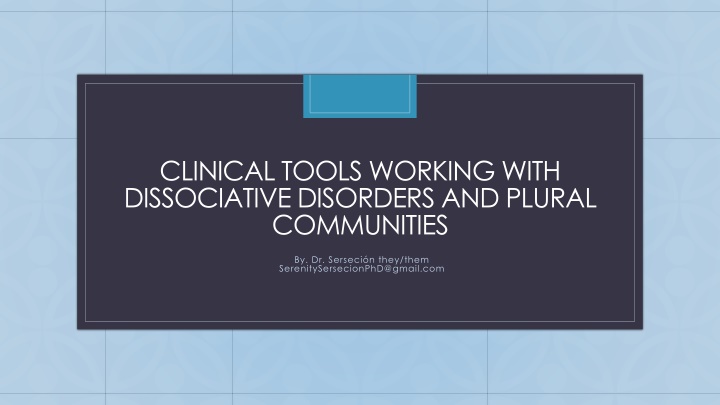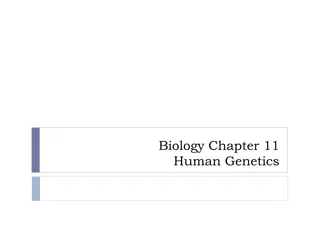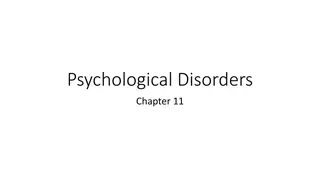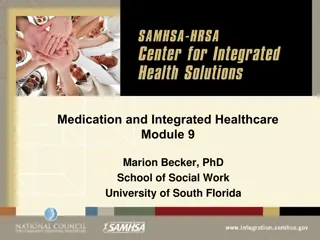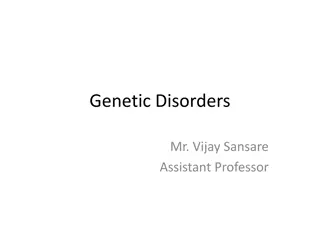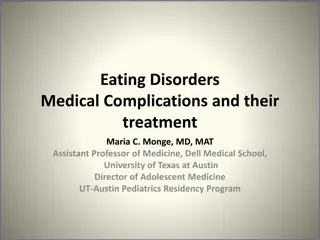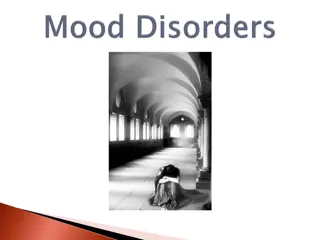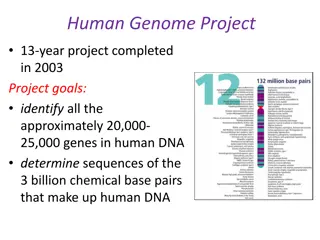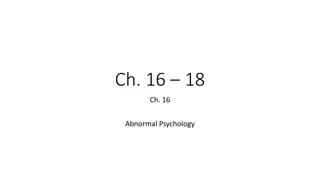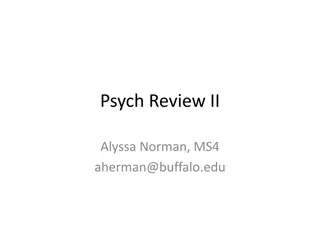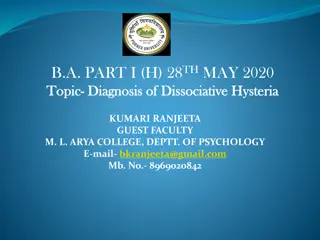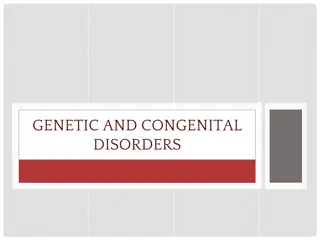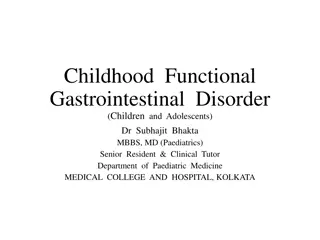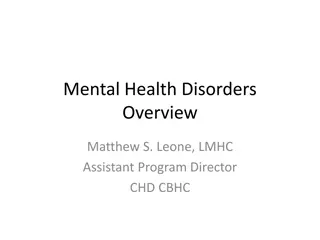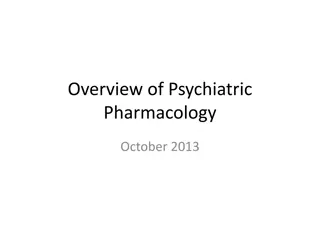Clinical Tools for Dissociative Disorders
Dissociative disorders involve disruption in consciousness, memory, identity, and more. Learn about diagnoses like DID and dissociative amnesia, their symptoms, and impacts on functioning.
Download Presentation

Please find below an Image/Link to download the presentation.
The content on the website is provided AS IS for your information and personal use only. It may not be sold, licensed, or shared on other websites without obtaining consent from the author.If you encounter any issues during the download, it is possible that the publisher has removed the file from their server.
You are allowed to download the files provided on this website for personal or commercial use, subject to the condition that they are used lawfully. All files are the property of their respective owners.
The content on the website is provided AS IS for your information and personal use only. It may not be sold, licensed, or shared on other websites without obtaining consent from the author.
E N D
Presentation Transcript
CLINICAL TOOLS WORKING WITH DISSOCIATIVE DISORDERS AND PLURAL COMMUNITIES C By. Dr. Serseci n they/them SerenitySersecionPhD@gmail.com
About Me Clinical Psychologist Gender queer They/Them/Ellos Puerto Rican English second language speaker Worked with the LGBTQ+ and Plural / DID communities through entire career
Dissociative Diagnosis Dissociative disorders are characterized by a disruption of and/or discontinuity in the normal integration of consciousness, memory, identity, emotion, perception, body representation, motor control, and behavior. Dissociative symptoms can potentially disrupt every area of psychological functioning. Often caused by traumatic experiences. Potential diagnosis are dissociative identity disorder (DID), dissociative amnesia, depersonalization/derealization disorder, other specified dissociative disorder (OSDD), and unspecified dissociative disorder. DSM 5 American Psychiatric Association (APA), 2013
Dissociative Diagnosis Dissociative Identity Disorder 300.14 (F44.81) Disruption of identity characterized by two or more distinct personality states, which may be described in some cultures as an experience of possession. The disruption in identity involves marked discontinuity in sense of self and sense of agency, accompanied by related alterations in affect, behavior, consciousness, memory, perception, cognition, and/or sensory-motor functioning. These signs and symptoms may be observed by others or reported by the individual. Recurrent gaps in the recall of everyday events, important personal information, and/or traumatic events that are inconsistent with ordinary forgetting.
Dissociative Diagnosis DID continued. The symptoms cause clinically significant distress or impairment in social, occupational, or other important areas of functioning. The disturbance is not a normal part of a broadly accepted cultural or religious practice. Note: In children, the symptoms are not better explained by imaginary playmates or other fantasy play. The symptoms are not attributable to the physiological effects of a substance (e.g., blackouts or chaotic behavior during alcohol intoxication) or another medical condition (e.g., complex partial seizures)
Dissociative Diagnosis Dissociative Amnesia 300.12 (F44.0) An inability to recall important autobiographical information, usually of a traumatic or stressful nature, that is inconsistent with ordinary forgetting. Note: Dissociative amnesia most often consists of localized or selective amnesia for a specific event or events; or generalized amnesia for identity and life history. The symptoms cause clinically significant distress or impairment in social, occupational, or other important areas of functioning.
Dissociative Diagnosis Dissociative Amnesia continued. The disturbance is not attributable to the physiological effects of a substance, or a neurological or other medical condition, or other neurological condition). The disturbance is not better explained by dissociative identity disorder, posttraumatic stress disorder, acute stress disorder, somatic symptom disorder, or major or mild neurocognitive disorder. 300.13 (F44.1) With dissociative fugue: Apparently purposeful travel or bewildered wandering that is associated with amnesia for identity or for other important autobiographical information.
Dissociative Diagnosis Depersonalization/Derealization Disorder 300.6 (F48.1) The presence of persistent or recurrent experiences of depersonalization, derealization, or both: Depersonalization: Experiences of unreality, detachment, or being an outside observer with respect to one s thoughts, feelings, sensations, body, or actions (e.g., perceptual alterations, distorted sense of time, unreal or absent self, emotional and/or physical numbing). Derealization: Experiences of unreality or detachment with respect to surroundings (e.g., individuals or objects are experienced as unreal, dreamlike, foggy, lifeless, or visually distorted).
Dissociative Diagnosis Depersonalization/Derealization continued. During the depersonalization or derealization experiences, reality testing remains intact. The symptoms cause clinically significant distress or impairment in social, occupational, or other important areas of functioning. The disturbance is not attributable to the physiological effects of a substance (e.g., a drug of abuse, medication) or another medical condition (e.g., seizures). The disturbance is not better explained by another mental disorder, such as schizophrenia, panic disorder, major depressive disorder, acute stress disorder, posttraumatic stress disorder, or another dissociative disorder.
Dissociative Diagnosis Other Specified Dissociative Disorder 300.15 (F44.89) This category applies to presentations in which symptoms characteristic of a dissociative disorder that cause clinically significant distress or impairment in social, occupational, or other important areas of functioning predominate but do not meet the full criteria for any of the disorders in the dissociative disorders diagnostic class. Examples: Chronic and recurrent syndromes of mixed dissociative symptoms: Identity disturbance associated with less-than-marked discontinuities in sense of self and agency, or alterations of identity or episodes of possession in an individual who reports no dissociative amnesia.
Dissociative Diagnosis OSDD Continued. Identity disturbance due to prolonged and intense coercive persuasion: Individuals who have been subjected to intense coercive persuasion (e.g., brainwashing, thought reform, indoctrination while captive, torture, long-term political imprisonment, recruitment by sects/cults or by terror organizations) may present with prolonged changes in, or conscious questioning of, their identity. Acute dissociative reactions to stressful events: Acute, transient conditions that typically last less than 1 month, and sometimes only a few hours or days. These conditions are characterized by constriction of consciousness; depersonalization; derealization; perceptual disturbances (e.g., time slowing, macropsia); micro-amnesias; transient stupor; and/or alterations in sensory-motor functioning (e.g., analgesia, paralysis).
Dissociative Diagnosis OSDD continued Dissociative trance: This condition is characterized by an acute narrowing or complete loss of awareness of immediate surroundings that manifests as profound unresponsiveness or insensitivity to environmental stimuli. The unresponsiveness may be accompanied by minor stereotyped behaviors (e.g., finger movements) of which the individual is unaware and/or that he or she cannot control, as well as transient paralysis or loss of consciousness. The dissociative trance is not a normal part of a broadly accepted collective cultural or religious practice.
Dissociative Diagnosis Unspecified Dissociative Disorder 300.15 (F44.9) This category applies to presentations in which symptoms characteristic of a dissociative disorder that cause clinically significant distress or impairment in social, occupational, or other important areas of functioning predominate but do not meet the full criteria for any of the disorders in the dissociative disorders diagnostic class. The unspecified dissociative disorder category is used in situations in which the clinician chooses not to specify the reason that the criteria are not met for a specific dissociative disorder and includes presentations for which there is insufficient information to make a more specific diagnosis (e.g., in emergency room settings).
Differential Diagnosis Posttraumatic Stress Disorder (PTSD) 309.81 (F43.10) Exposure to actual or threatened death, serious injury, or sexual violence Presence of one (or more) intrusion symptoms associated with the traumatic event(s), beginning after the traumatic event(s) occurred. Dissociative reactions (e.g., flashbacks) in which the individual feels or acts as if the traumatic event(s) were recurring. (Such reactions may occur on a continuum, with the most extreme expression being a complete loss of awareness of present surroundings.) Persistent avoidance of stimuli associated with the traumatic event(s), beginning after the traumatic event(s) occurred.
Differential Diagnosis PTSD Continued Negative alterations in cognitions and mood associated with the traumatic event(s), beginning or worsening after the traumatic event(s) occurred, as evidenced by two (or more) of the following (listed dissociative sxs) Inability to remember an important aspect of the traumatic event(s) (typically due to dissociative amnesia and not to other factors such as head injury, alcohol, or drugs) Feelings of detachment or estrangement from others. Persistent inability to experience positive emotions (e.g., inability to experience happiness, satisfaction, or loving feelings). Marked alterations in arousal and reactivity associated with the traumatic event(s), beginning or worsening after the traumatic event(s) occurred, as evidenced by two (or more) sxs.
Differential Diagnosis PTSD with dissociative symptoms: The individual s symptoms meet the criteria for posttraumatic stress disorder, and in addition, in response to the stressor, the individual experiences persistent or recurrent symptoms of either of the following: Depersonalization: Persistent or recurrent experiences of feeling detached from, and as if one were an outside observer of, one s mental processes or body (e.g., feeling as though one were in a dream; feeling a sense of unreality of self or body or of time moving slowly). Derealization: Persistent or recurrent experiences of unreality of surroundings (e.g., the world around the individual is experienced as unreal, dreamlike, distant, or distorted).
DEFINITIONS & TERMS C
Theories regarding causes of dissociation Dissociation can be a way to protect someone. A rest or break from reality, especially from traumatic experiences. Can help person live life separate from traumatic experiences. Person may be unable to process something, and the result is dissociation and/or fragmentation. Plurality: Healthy multiplicity aka non disordered. Trauma Based System: System who believes their multiplicity/plurality comes from traumatic experiences. Endogenic System / Natural Plurality or Natural Multiplicity: System that was born plural and/or who believes this is their natural state. Any type of system may have experienced severe trauma, regardless of origin. Singlet: Term used for non-plurals / one person in one body.
Definitions System: Multiple people sharing one body. Host: Person out the most, can be more than one person. Some system do not have a host. Fronting: Person outside at the moment. Can also be more than one person (co-fronting) Age-Sliding: Someone who moves from one age to another. At times due to being triggered but may have other causes. Blurring: Loss of identity for those fronting due to multiple people being out at once and having difficulty telling who is who. Also, may be due to increased dissociation or stress.
Plural / DID Terms Plurality: Healthy multiplicity aka non disordered. Or an umbrella term for all systems Or a term outside of the DSM/psychiatric community similar to gender terms outside of the binary Singlet: Term used for non-multiples / one person in one body. Origin of system: There are various origins of systems which are debated in communities and in the psychiatric/psychological community. We are focusing on systems as a whole and not a specific type of origin
Singletsona A singletsona is the persona a system presents to the world as a singlet version of themselves. Sometimes this can be one or a few people in the system Other times it s a new persona or mask in which system members agree to try and act in a specific way There are many ways to have a singletsona
What does a system look like internally? Can be very different. Some examples: A stage A house A room Towns, and cities Forests, lakes, fields. Many other options
How are people out? (Fronting) For example, in the stage internal world perhaps the person or people out are in the spotlight internally. For the house example, someone may exit the house to be out. Varies greatly by system Other reasons why someone is out: Triggers Positive (wanting a food you like) or negative (trauma) Wanting to be out for an experience (example toy store, talking to friends). Or just because!
UNDERSTANDING THE COMMUNITY C
Discussion For singlets, if you were a system Would you all be out to friends and family as a system, or would you identify as a singlet ? What are the consequences of both options? How may this affect your daily life? How would you navigate the world?
BUILDING RAPPORT Working on helping them feeling safe and able to build trust. As a system and individually. Items for kids and teens in the therapy room. Coloring books, plushies, toys, etc. Letting clients take the lead regarding when or if they disclose any difficult/traumatic memories. Also, when asking who is out How to do this? What do the clients prefer?
MICRO AND MACROAGGRESSIONS Here are some common problematic comments and behaviors from therapists: I want to talk to the real one . I ll only call you by the birth / legal name. Silence when anyone other than the host is out. Stating that others in headspace are imaginary . Asking for only one person to come to session and others cannot attend. Treating kids and teens as if they are adults.
How do you address people in a system First be respectful of system, treat people as individuals. Unless the system tells you differently. Use the terms the system uses for themselves. Some common terms are alters, headmates, & parts. Other ways to address each other: by name, siblings, family, cousins, friends, etc. Similar to singlets, addressing each other based on relationship type.
How to be respectful in treatment As a clinician address individuals by their name, not only the legal name of the body. Do not ask Who s the real person? or Who s the original person . This can be seen as offensive, and many times may not make sense. If a systems fits into this category, they will tell you. Remember that our field is pathologizing of this group/community. Think of your position and power dynamics between you and clients. Focus on building trust and safety If with client with DID and someone else comes out, how to ask? It is still..? You can also be honest and say you aren t sure who is out. Ask client how to notify you of any change if they can. Also, check in on how to ask them respectfully in the future.
Media Representation Pretty bad often systems are depicted as murderers or violent and unstable and other terrible examples. The movie Split is an example of this. Some things discussed in this movie were true making the overall message worse. For example, some of the dialogue of the psychologist. YouTube, TikTok, Instagram and other social media has systems discussing their experiences. Possible to find some good resources for clients.
Community Events Local meet ups Meet-ups at larger events such as conferences, pride events and more. Online meet-ups and groups Social Media Reddit Subreddits such as: plural, DID, OSDD, Tulpas, and more Discord Has various groups to pick from Best to review if the group s focus fit what you are looking for Some are exclusive to certain system types or topics Meet-up Discords exist based on location and overall focus
Pride events Dissociation Awareness Day March Day focused on dissociative disorders Multiplicity May: Entire month of May Lists of prompts to write or share about each day of the month Plural Acceptance Week: Mid-July (Power to the Plurals & Plural Events) Focused on acceptance of all plurals, 2020 Plural Pride Day in July
INTERSECTING IDENTITIES TO CONSIDER Age Class Gender Identity SES Race Ethnicity Sexual Orientation Religion Country of origin Language(s) Spoken Body Size Country you live in Education Social Mobility Parent Status Access to technology, books, food Location of Residence Physical / Cognitive Ability Political environment of country of residence Mental Health Physical Health
EFFECT OF PRIVILEGE AND MARGINALIZATION Clinician is in a position of authority If the client has experienced trauma from an authority figure this may increase projection and transference New clinicians may not understand or accept being seen as authority figure This may cause more distress from client s different understanding of the dynamic
EFFECT OF PRIVILEGE AND MARGINALIZATION Plural and Dissociative populations are often stigmatized by our profession This add to the potential distance between a clinician and client If a clinician is not aware of this dynamic, they may be more likely to perpetuate microaggressions due to inexperience.
DIFFERENCE BETWEEN SYSTEM MEMBERS System members can be completely different from each other. Some possible differences: Gender, sexuality, age, language spoken, body type, clothing style, ideologies, religion, interests and much more. Do not assume that system members share intersectional identities. May be more like siblings in that they were raised by the same parents and in the same household but can be very different from each other.
Intersectionality The intersection of various identities in each individual in the system and the body or system as a whole. For example, the intersections of race, class, gender, SES, and other identities. Intersectionality creates systems of overlapping identities which connect to marginalization and privilege. Can be difficult to identify all the different intersectional identities we each have. Important to evaluate the intersections between you as a therapist and your clients.
How does gender identity and sexual orientation present in systems? There may be various different gender identities and sexual orientations in the same system. Check in with the system about this and if possible, ask for a system list Use gender neutral language until you know more about each system member
How does gender identity and sexual orientation present in systems? Work with the system on having this information if they are open about this and feel safe discussing these topics If not, focus on rapport building first Do not assume that anyone in the system matches the gender assigned at birth Also, if someone does, do not assume they are the real person or core . That may not even exist.
How to explore this Gender Identity Do you feel you are a man, woman, neither, both? Gender Expression How do you present yourself? Male, female, androgynous? Biological sex Refers to genitalia. Gender assignment at birth. Sexual Orientation Who are you attracted to? Males, females, both, neither
Pronouns There are different pronouns system members may use. She/her He/him They/them Or a combination of these Also, neo pronouns such as: Ze/zir Fae/faer Xe/xir Some systems use different pronouns for them as a system as opposed to individually. Incorrect pronoun usage is invalidating and hurtful Can be seen as denying the individual's reality Conveying that you are not an ally
CLINICAL INTERVENTIONS C Break time!
Treatment Coming into treatment: Some may not be aware yet of being a system. Some may be aware but afraid to be open due to stigma, negative experiences with providers, view of psychology towards being plural. Example: not being real), personal denial and many other reasons. More often, systems come in for depression, anxiety, trauma, Bipolar, PTSD and other concerns. Some may want help in communicating, others may think integration is the only way to be healthy.
Treatment Traditionally integration seen as only alternative. One metaphor is a vase that breaks due to trauma and the therapist helps glue it back together. This may be true for some, for others it s more like multiple vases. The idea is that through processing trauma people in the system will no longer be needed and integrate into one new complete person. However, although some want this, for others it may feel like death or murder of family . Being a system is a valid form of living as well, set goals with the clients.
Treatment Other alternatives for treatment: Work on co-consciousness, reducing lost time and increasing communication. Sometimes individuals may join together (fuse or integrate). Fragments may disappear, but the system remains a system (although possibly smaller). Switching is purposeful, does not happen unintentionally or rarely. Help the system learn more grounding tools and ways to communicate internally and externally.
WHAT DOES PLURAL POSITIVE MEAN? Focus on the entire plural community. Regardless of origin (traumagenic, endogenic, quoigenic). Clients decide on goals. Clinicians should express their assessment and potential goals but these need to be agreed upon with clients. Integration is not the main focus. Integration in the clinical sense refers to becoming a singlet. One person = everyone combined. Instead, communication within system members is a focus.
WHAT DOES PLURAL POSITIVE MEAN? If there are blackouts, lost time, or conflicts within the system, these need to be addressed first. If there is trauma, teaching coping mechanisms and then working on processing. Helping relationship and communication between system members if needed. Also, practical concerns such as scheduling fronting time, taking care of tasks internally and externally, anything else important to the system.
WHEN PLURALITY ISNT THE FOCUS OF TREATMENT Many therapists assume that if someone is plural, that is the focus of treatment. As a therapist you may think that the goals are completely connected to plurality, ignoring other concerns. Therapists should be open to the clients goals and not assume plurality is the problem . & understanding that the problem may be being plural in a singlet world.
